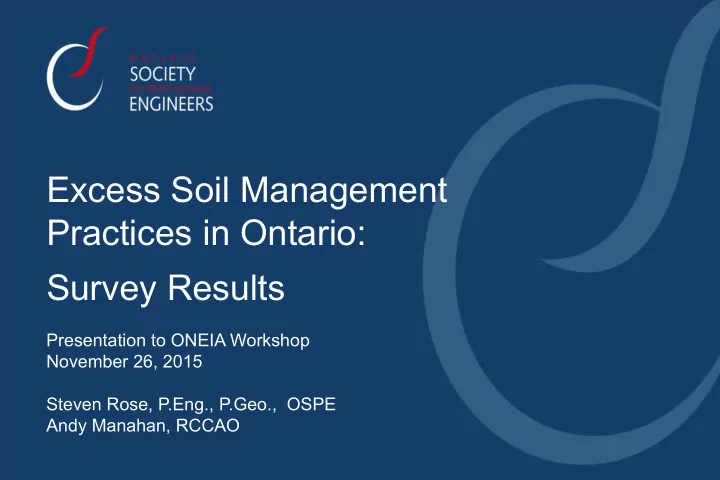

Excess Soil Management Practices in Ontario: Survey Results Presentation to ONEIA Workshop November 26, 2015 Steven Rose, P.Eng., P.Geo., OSPE Andy Manahan, RCCAO
Survey Collaborators Ontario Society of Professional Engineers Residential and Civil Construction Alliance of Ontario Greater Toronto Sewer & Watermain Contractors Association
Key Issues / Considerations Expense: • There is a perceived expense to infrastructure projects where soils have no beneficial re-use (onsite or offsite) o Trucking / Disposal / Make-up Fill Environmental Impacts: • Air Emissions / Noise • Resource Depletion (soil / landfill capacity) • Traffic Congestion • Other
Key Issues / Considerations Other Concerns: • Impact to municipal budgets (limited spending available for other priorities) • Wear and tear on roads due to heavy truck traffic • Current practice defaults are ultra-conservative (liability avoidance) • Undesirable precedents (problems reported in the press) • Regulatory uncertainties • Substandard practices by QPs • Geotechnical suitability of soils for re-use
Survey Goals & Design Survey Goals: • Benchmark current industry practices against: “Management of Excess Soil – A Guide for Best Management Practices” (2014 – “BMPs”) • Understand the magnitude of soil movement on infrastructure projects • Investigate opportunities for improvement of current industry practices • Evaluate potential savings in reducing the volume of soils relocated for infrastructure projects
Survey Goals & Design Survey Goals (cont’d): • Evaluate the contributions of current excess soil management practices to GHG emissions in Ontario (and opportunities for their reduction) • Provide support for municipal adoption of best practices (such as creation of a model by-law ) • Develop improved management practices for excess soils that can yield lower project costs and lower GHG emissions
Survey Goals & Design Survey Design & Inputs: • Prepared & conducted - Summer 2015 • 33 questions o Type of company responding o Typical projects & geographic coverage o Project values o Costs / distances for exporting and importing soils for projects o Ultimate disposition of exported soils (landfill / re-use) o Use of 2014 BMPs for soil management / cost savings realized • Distributed to membership & networks of the 3 sponsoring groups • 16 full surveys completed – provides a snapshot of (29) current projects
Survey Results Survey Respondents / Project Types: • 56% Earthworks Contractors • 25% Consultants • All respondents active in GTHA / 19% also active elsewhere
Survey Results
Survey Results Who makes the decisions on where to take excess soils? • 88% General Contractor or Earthworks Subcontractor o Receiving site often selected with input from the Consultant
Survey Results
Survey Results
Survey Results
Survey Results What was the typical travel distance (1 way)? • For soil disposal: 70 km (inferred mean distance) What was the typical number of loads? • Dual Axle: 78% of projects > 100 loads • Tri-Axle: 86% of projects > 100 loads • Truck & Trailer: 100% of projects > 100 loads Total Estimated Distance Travelled (24 projects): ~ 170,000 km
Survey Results Project Dimensions:
Survey Results
Survey Results Was a soil management plan (as recommended by the 2014 BMP) used? • 25% = YES o out of this group, ¾ sent less than 10% of excess soils to landfill What additional project costs were incurred? • ½ cost more than $10,000
Survey Results Did a BMP approach create any project savings? • Over 50% of projects achieved a project cost savings of 5% or less o One of these projects had a total value greater than $50M o The estimated dollar value of savings for that project is at least $1.2M • Close to 45% of projects achieved project cost savings between 10% and 20%
Survey Results
Summary 4 (Preliminary) Take Away Points: • A small sampling of projects shows large volumes of soil are being transported substantial distances for infrastructure projects. • 9 projects with linear length > 1 km; costs to manage excess soils were ~ 10% of project costs (estimated mean value of $5M for soil management) • Costs to undertake soil management plans are in the $thousands; potential savings are in the $millions. • Environmental impacts of current practices are significant (emissions, loss of resources, traffic congestion and road wear).
Further Information Steven Rose: rose@malroz.com www.ospe.on.ca Andy Manahan: manahan@rccao.com www.rccao.com www.gtswca.org
Recommend
More recommend